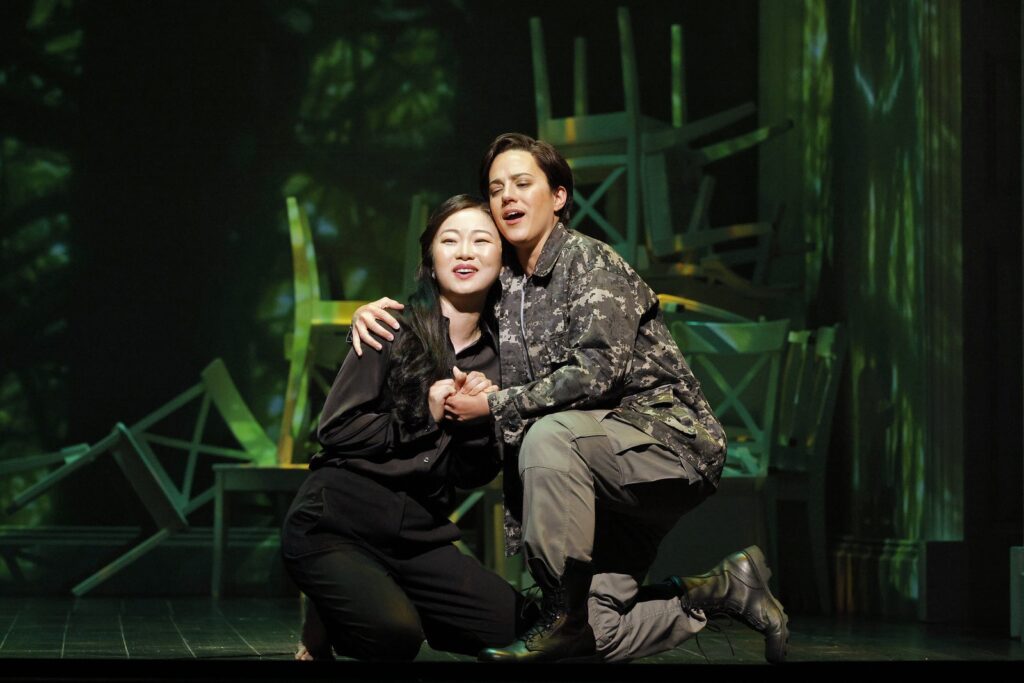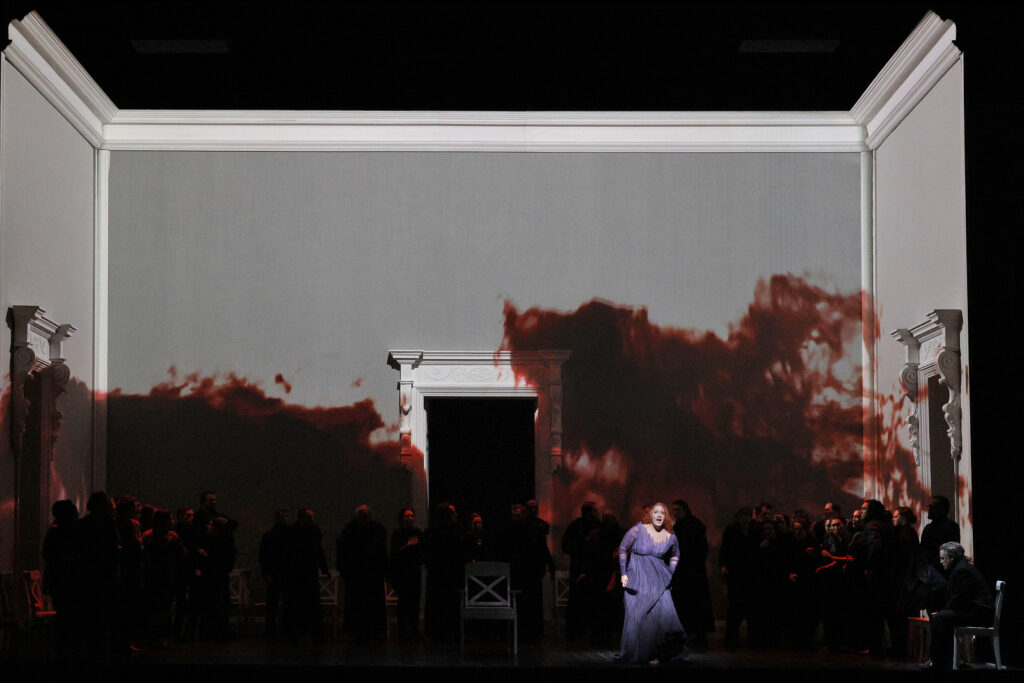To make a long story short, Ilia loves Idamande but can’t admit it. Elektra loves Idamante and admits it. Idomeneo loves his son Idamante but promised Neptune that he would kill him [his son].
It all works out in the end, through absolutely splendid music — though it’s a three and a half hour wait until Elettra cuts loose with the jealous rage we’ve all been waiting for.
Idomeneo straddles the fence between Italian opera seria with its arias and dry recitatives and French Baroque opera with the rich orchestration of its concerted recitatives and its episodes of dance. Unfortunately these days Mozart’s dances for Idomeneo are not performed — an additional hour of music would be exhausting for today’s audiences (not to mention the cost of dancers). It is possible that these dances have never been included in an Idomeneo performance.
It all began in the pit where conductor Eun Sun Kim summarily executed the famed D major overture. She then held solid the musical tension needed to connect the 13 arias that comprise the opera, plus the intermittent choruses that express the horrors inflicted by Neptune’s revenge. The maestra had Mozart’s full symphonic resources — double winds, two trumpets and four horns, strings and timpani — at her disposal. It is heroic music — the sorrows of defeat, the wreckage of revenge, the interference of higher powers (fate) — against filial love, romantic love, and Elettra’s emotional wreckage. Conductor Kim, San Francisco Opera’s music director, does indeed relish the heroic, adding her penchant for the heroic to her obvious delight in working with the voices of singers appropriate to such music.

A stellar cast exposed the glories of this first opera of the young Mozart’s maturity.
Idomeneo was sung by tenor Matthew Polenzani (lead photo, far left) who held forth magnificently in his three arias, though he had huge presence in the concerted trio in Act II, and quartet in Act III. Mr. Polenzani comes to this Cretan king via most of the repertory’s important lyric tenor roles — Don Carlo, Florestan, Werther, as examples — sung on the world’s major stages. Thus he solidly inhabited Idomeneo, imparting into his character high drama and heroic sensitivity, attributes It demands. At age 57, in prime vocal estate, he gives the role both his maturity and his authority.
His son Idamante, a castrato role, was sung by mezzo soprano Daniela Mack, the Idamante in San Francisco Opera’s 2008, John Copley production. Mme. Mack brought rich voice and dramatic conviction to the role, and she projected a graceful charm in her trouser-role movement that gave much pleasure to watch. In fact this grace and charm did much to bind the opera into a dramatic whole. Idamante, as all the protagonists, had an aria in each act. Before the third act an announcement was made that Mme. Mack was not feeling well, and asked our indulgence, perhaps explaining the vocal tentativeness that we felt from the beginning, then confirmed in her final aria.
Idamante’s intended, Ilia, was sung by Chinese born, New York finished soprano Ying Fang, Ilia a role sung by Mlle. Fang also at the Metropolitan Opera and at the Salzburg Festival. Ilia has the first aria in the opera, lamenting her fate — her father, Troy’s King Priam, was killed in the war with Crete, her countrymen taken prisoner. In limpid voice of exceptional beauty, imbued with impeccable musicianship, she confessed an impossible love for Idamante, though in the opera’s only duet (Act III) they profess their love for one another. Finally, in Idomeneo’s final aria, Ilia is made queen of Crete, joining Idamante as king.
Elettra, who always knows that her love for Idamante is hopeless, was sung by Elza van den Heever, certainly still basking in her recent triumph as Salome at the Met. She raged in her first act aria, purred in the second act as she is sent off into exile with Idamante,. But she lost all control in the third act when, in the opera’s final moments, she understands at last that she simply cannot have Idamante. It was a truly magnificent rage before she stormed off to kill herself.
Idomeneo’s confidant, Arbace was sung by baritenor Alek Shrader. As a facilitator rather than actor in the drama, Mozart gave him only two arias, one of which is a standard cut in the opera’s modern revivals. Mr. Shrader sang his second act “Se il tuo duol” beautifully, if distantly, underscoring his superfluousness to the story.
The San Francisco Opera Chorus made the suffering of the Trojan prisoners beautifully felt, enacted the terrified Cretans suffering the wrath of Neptune, and celebrated their new king and queen with finesse and panache, holding twigs of eucalyptus.
The 2023 production was from Sydney’s Opera Australia, imagined by Australian stage director Lindy Hume, who works primarily there and in New Zealand, her few American credits include productions for Philadelphia and Seattle.
Mme. Hume updates her Idomeneo from the Bronze Age to contemporary times, placing it in Tasmania, from where some of the projected images of nature came (flying birds, forests). The set itself, by American scenographer Michael Yeargan was but a large room, each of its three sides held a large door of 18th century inspiration. The room’s floor was a revolving platform. Often a few, or many armless chairs were carried on or off, and placed in lines, or randomly, a white chair with arms served as a throne. Covered with a red cloth it became an altar.
The room box could be both solid walls, or transparent walls, or a screen on which colored images appeared, sometimes live (moving) images of actual nature, other times of flowing shapes and colors that abstractly illustrated a public or private emotional state. The very effective projections were by David Bergman, a designer who works primarily in Sydney. Lighting was by Australian designer Verity Hampson, effected by San Francisco resident lighting designer Justin Partier.
Otherwise the decor were the costumes, by Australian designer Anna Cordingley. It was contemporary dress, Ilia at the end in a simple black, form fitting dress, Elettra in an elaborate gown and wig. Idomeneo was in a the gray toga of a war survivor, when not covered by a vaguely stone age, Tasmanian mantle. Idamante first wore a light colored business suit with a bright tie, the bespectacled Arbace was in nondescript, casual business attire.

Nothing more. No sea monster. The actors were in fact the scenery, and were very affectively moved here and there by director Hume, always precisely enacting the story.
The two Cretan women and two Trojan men were Adler Fellows (San Francisco Opera’s young artist program), as were the High Priest of Neptune, effectively sung by tenor Samuel White, and the Voice of the Oracle, effectively sung by bass Jongwon Han.
Michael Milenski
War Memorial Opera House, San Francisco, California USA, June 14, 2025.
All photos copyright Cory Weaver, courtesy of San Francisco Opera.